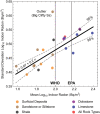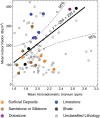A Geologically Based Indoor-Radon Potential Map of Kentucky
- PMID: 33283125
- PMCID: PMC7682569
- DOI: 10.1029/2020GH000263
A Geologically Based Indoor-Radon Potential Map of Kentucky
Abstract
We combined 71,930 short-term (median duration 4 days) home radon test results with 1:24,000-scale bedrock geologic map coverage of Kentucky to produce a statewide geologically based indoor-radon potential map. The test results were positively skewed with a mean of 266 Bq/m3, median of 122 Bq/m3, and 75th percentile of 289 Bq/m3. We identified 106 formations with ≥10 test results. Analysis of results from 20 predominantly monolithologic formations showed indoor-radon concentrations to be positively skewed on a formation-by-formation basis, with a proportional relationship between sample means and standard deviations. Limestone (median 170 Bq/m3) and dolostone (median 130 Bq/m3) tended to have higher indoor-radon concentrations than siltstones and sandstones (median 67 Bq/m3) or unlithified surficial deposits (median 63 Bq/m3). Individual shales had median values ranging from 67 to 189 Bq/m3; the median value for all shale values was 85 Bq/m3. Percentages of values falling above the U.S. Environmental Protection Agency (EPA) action level of 148 Bq/m3 were sandstone and siltstone: 24%, unlithified clastic: 21%, dolostone: 46%, limestone: 55%, and shale: 34%. Mississippian limestones, Ordovician limestones, and Devonian black shales had the highest indoor-radon potential values in Kentucky. Indoor-radon test mean values for the selected formations were also weakly, but statistically significantly, correlated with mean aeroradiometric uranium concentrations. To produce a map useful to nonspecialists, we classified each of the 106 formations into five radon-geologic classes on the basis of their 75th percentile radon concentrations. The statewide map is freely available through an interactive internet map service.
Keywords: geohealth; geologic map; lung cancer; public health; radon; scientific communication.
©2020. The Authors.
Conflict of interest statement
The authors declare no conflicts of interest relevant to this study.
Figures









References
-
- American Cancer Society (2019). Cancer facts and figures 2019. Atlanta, GA: American Cancer Society; Retrieved from https://www.cancer.org/content/dam/cancer‐org/research/cancer‐facts‐and‐...
-
- Anderson, W. H. , Sparks, T. N. , & Weisenfluh, G. A. (2004). Completion of the first phase of the Kentucky digital geologic mapping program In Digital mapping techniques '04—Workshop proceedings (U.S. Geological Survey Open‐File Report 2004–1451). Washington, DC: U.S. Geological Survey; Retrieved from https://pubs.usgs.gov/of/2004/1451/anderson/index.html
Grants and funding
LinkOut - more resources
Full Text Sources
Research Materials
